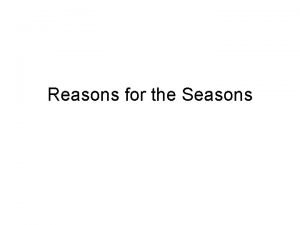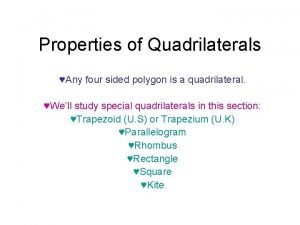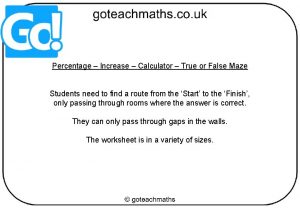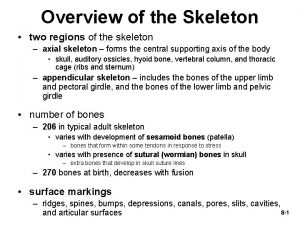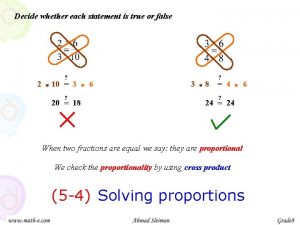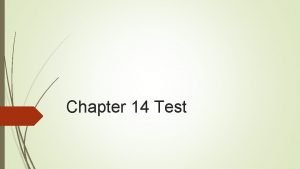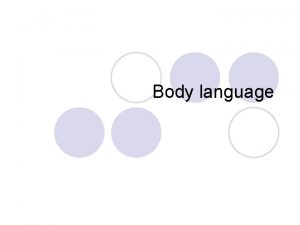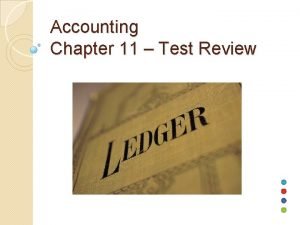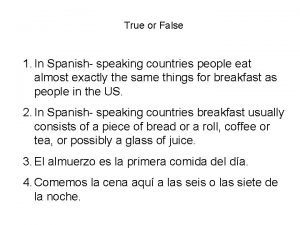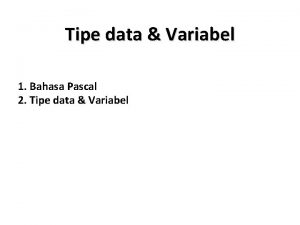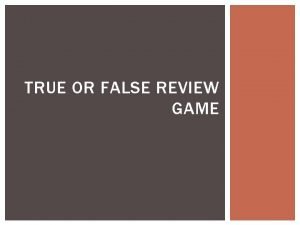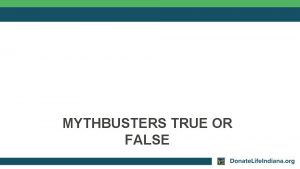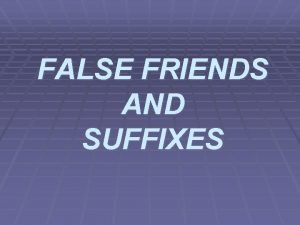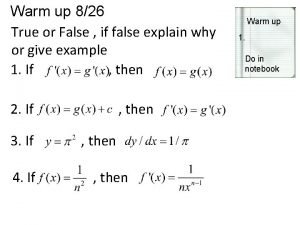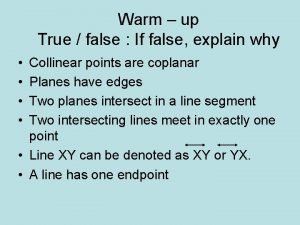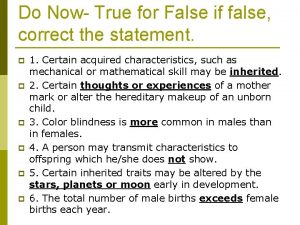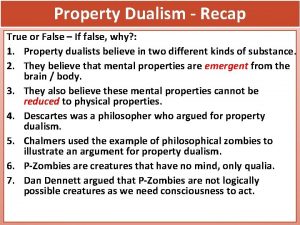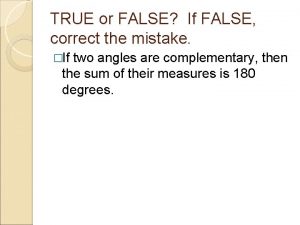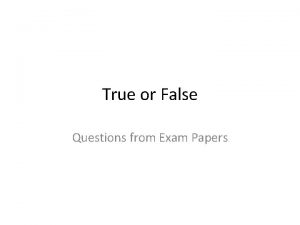Section 3 Review Mr Crone True or false


































- Slides: 34

Section 3 Review Mr. Crone

True or false? bool x = true; int y = 5, z = 6; (y > z && x )

True or false? bool x = true; int y = 5, z = 6; (y > z && x ) // F

True or false? bool x = true; int y = 5, z = 6; (y > z || !x )

True or false? bool x = true; int y = 5, z = 6; (y > z || !x ) // False!

True or false? bool x = true, y = false, z = false (x && !y && !z)

True or false? bool x = true, y = false, z = false (x && !y && !z) True!

What does the code print? int x = 4, y = 2, z = 1; if(y ==2) if( z ==1) x += 6; else x =4; else x += 8; cout << x << endl;

What does the code print? int x = 4, y = 2, z = 1; if(y ==2) // True if( z ==1) // True x += 6; // x = 10 else x =4; else x += 8; cout << x << endl;

What does the code print? int x = 54; if(x>= 5 && x <= 100) x = 4; else x = 5; cout << x << endl;

What does the code print? int x = 54; if(x>= 5 && x <= 100) // True x = 4; // x = 4 else x = 5; cout << x << endl; // 4

What does the code print? bool var = true; bool var 2 = false; if( !(!var && var 2)) cout << “ 1”; else cout << “ 2”;

What does the code print? bool var = true; bool var 2 = false; if( !(!var && var 2)) // True cout << “ 1”; // Prints 1 else cout << “ 2”;

What does the code print? int x = 14; if(x < 10) cout << “ 1”; if (x > 10) cout << “ 2”; if ( x >10 && x < 20) cout << “ 3”; if(x ==10 || x ==14) cout << “ 4”;

What does the code print? int x = 14; if(x < 10) // false cout << “ 1”; if (x > 10) // true cout << “ 2”; if ( x >10 && x < 20) // true cout << “ 3”; if(x ==10 || x ==14) // true cout << “ 4”; Prints: 234

int x = 4; bool var = true; if( var) cout << “ 1” ; else if(x==4) cout << “ 2” ; else if (x ==4 && var) cout << “ 3”; else cout << “ 4”;

What does the code print? int x = 4; bool var = true; if( var)// true cout << “ 1” ; // Prints 1 else if(x==4) cout << “ 2” ; else if (x ==4 && var) cout << “ 3”; else cout << “ 4”;

True or False? bool var = false; bool var 2 = true; cout << (24/4%4>1 || !var && var 2) << endl;

True or False? bool var = false; bool var 2 = true; 24/4%4>1 || !var && var 2 6 % 4 > 1 || T 2 > 1 || T True Prints: 1

const int RADIUS = 3. 14; double num = 5. 5; bool x = false; if(!x) RADIUS += 4; else num= 17; cout << num << endl;

const int RADIUS = 3. 14; // ERROR! double num = 5. 5; bool x = false; if(!x) RADIUS += 4; // ERROR! else num= 17; cout << num << endl;

int x = 4, y = 5; bool is. Working = false; if(x> 0&& y > 0) is. Working = true; if(is. Working) x = 5; cout << x << y << endl;

int x = 4, y = 5; bool is. Working = false; if(x> 0&& y > 0) // True is. Working = true; if(is. Working) // True x = 5; cout << x << y << endl; // 55

int x = 4, y = 5; bool is. Working = false; if(x<y) if(is. Working) is. Working = false; else is. Working = true; else y = 20; cout << is. Working << endl;

int x = 4, y = 5; bool is. Working = false; if(x<y) if(is. Working) is. Working = false; else is. Working = true; else y = 20; cout << is. Working << endl; // Prints 1

int x = 4; double y = 2. 5; int yx = 3; cout << ((2*x)/3 < yx && 2 == int(y));

int x = 4; double y = 2. 5; int yx = 3; cout << ((2*x)/3 < yx && 2 == int(y)); // 8/3 < 3 && 2 == 2 // 2 < 3 && 2 ==2 // TRUE

List the logical operators in order of precedence with the operator with the highest precedence being listed first.

List the logical operators in order of precedence with the operator with the highest precedence being listed first. !, &&, ||

Provide two examples of unary operators.

Provide two examples of unary operators. ++, --, !

What is the decimal equivalent of the following binary number? 110100

What is the decimal equivalent of the following binary number? 110100 52

Operator Review Relational Operators: <, >, <=, >=, ==, != Logical Operators: !, &&, || Assignment Operator: = Shortcut Assignment Operators: +=, -=, /=, *=, %= Increment Operator: ++ Decrement Operator: -Arithmetic Operators: +, -, *, /, % Unary Operators (operator on one item): -, !, ++, -** Know when to use == vs. =
 Amer rasheed
Amer rasheed Andy crone
Andy crone Patricia crone hagarism
Patricia crone hagarism Baylee crone
Baylee crone False true
False true Transverse wave vs longitudinal wave
Transverse wave vs longitudinal wave Most groundwater comes from rain true or false
Most groundwater comes from rain true or false Which of these statements is true
Which of these statements is true False and true vocal cords
False and true vocal cords There are four season all over the world true or false
There are four season all over the world true or false Is any 4 sided polygon a quadrilateral
Is any 4 sided polygon a quadrilateral Percent increase and decrease maze
Percent increase and decrease maze Lumbat
Lumbat Take away any liquid near your working area true or false
Take away any liquid near your working area true or false Mla works cited indentation
Mla works cited indentation Truth table logical operators
Truth table logical operators True or false questions about leadership
True or false questions about leadership Methods of heat transfer
Methods of heat transfer Identify each statement as either true or false
Identify each statement as either true or false For each statement decide whether it is a function of the
For each statement decide whether it is a function of the Chapter 41 telephone techniques true or false
Chapter 41 telephone techniques true or false Accounting chapter 14 true and false
Accounting chapter 14 true and false Clarity is the soul of business letter true or false
Clarity is the soul of business letter true or false Body language is universal true or false
Body language is universal true or false Chapter 11 accounting test
Chapter 11 accounting test установите соответствие true и false
установите соответствие true и false Grains are types of grasses. true false
Grains are types of grasses. true false Me encantan los espaguetis. son muy _____.
Me encantan los espaguetis. son muy _____. Tipe data pada bahasa pascal adalah
Tipe data pada bahasa pascal adalah Tipe data logika yang bernilai true dan false ialah
Tipe data logika yang bernilai true dan false ialah True or false science questions
True or false science questions All spiders spin webs true or false
All spiders spin webs true or false Classify each statement as true or false
Classify each statement as true or false True or false psychology questions
True or false psychology questions Puffin crossing steady amber
Puffin crossing steady amber









